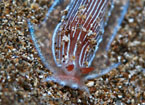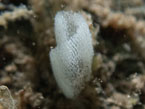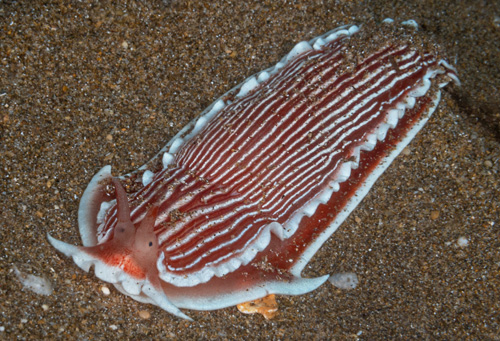| Home |
| Acknowledgments |
| Conventions |
| Glossary |
| Maps |
| References |
| Links |
| Articles |
| Thumbnails |
| Species
list |
| Family |
| Next
species |
Additional Photos

front

side

young

ontogeny

feeding

burrowing

probable egg mass

Dermatobranchus rubidus Gould, 1852

| Maximum size: 60 mm. (Kay,
1979). Identification: This is an elongate, translucent rust-red animal with white ridges and darker red rhinophores. Natural history: Kay (1979) lists it as seasonally abundant on Oahu's fringing reefs and an animal referenced in Gosliner &. Fahey, 2011 was collected from the intertidal in Kihei, Maui by S. Jazwinski in 1979. However, since 2020 numerous Maui animals where found on sand at 5-8 m (15-26 ft) by Rebecca Bicker and others. It's primarily nocturnal and, unlike most arminaceans, appears to feed on a small, sand-dwelling ceriantharian anemone (probably Arachnanthus sp.). (Note 1) It probably lays a one to two whorl white egg mass secured in the sand with an anchor of hardened mucus. Distribution: Maui, Oahu and Kauai: widely distributed in the western & central Pacific. Taxonomic notes: It is listed in Kay as Dermatobranchus rubida and was first reported from Hawaii in Gould, 1852 (as Diphyllidia rubida). Photo: Kelly McCaffrey: 50 mm: Maalaea Bay, Maui: June 5, 2022. Observations and comments: Note 1: Rebecca Bicker reported that "Right after I shot the anemone picture, the Dermatobranchus dove into the sand" and "I honestly did not see the anemone until I looked at the photos on my computer." So, perhaps the feeding sequence goes: animal bites anemone, anemone retracts puling animal into its hole, animal gets one good bite then "resurfaces" and moves on to the next anemone? Later, Jenna Szerlag and Kelly McCaffrey observed one feeding on multiple anemones over a two minute period and Jenna said "After it'd gobble up the anemone it would just go on to the next. I did not see it get sucked down into the tube like Rebecca did." However, the anemones in her photos were proportionately smaller than the one in Rebecca's. Perhaps, they were "overpowered" by the D. rubida? (see photos) Lloyd Johnson also photographed one attacking an anemone. |
| Thumbnails |
Species
list |
Family | Next species | Top |